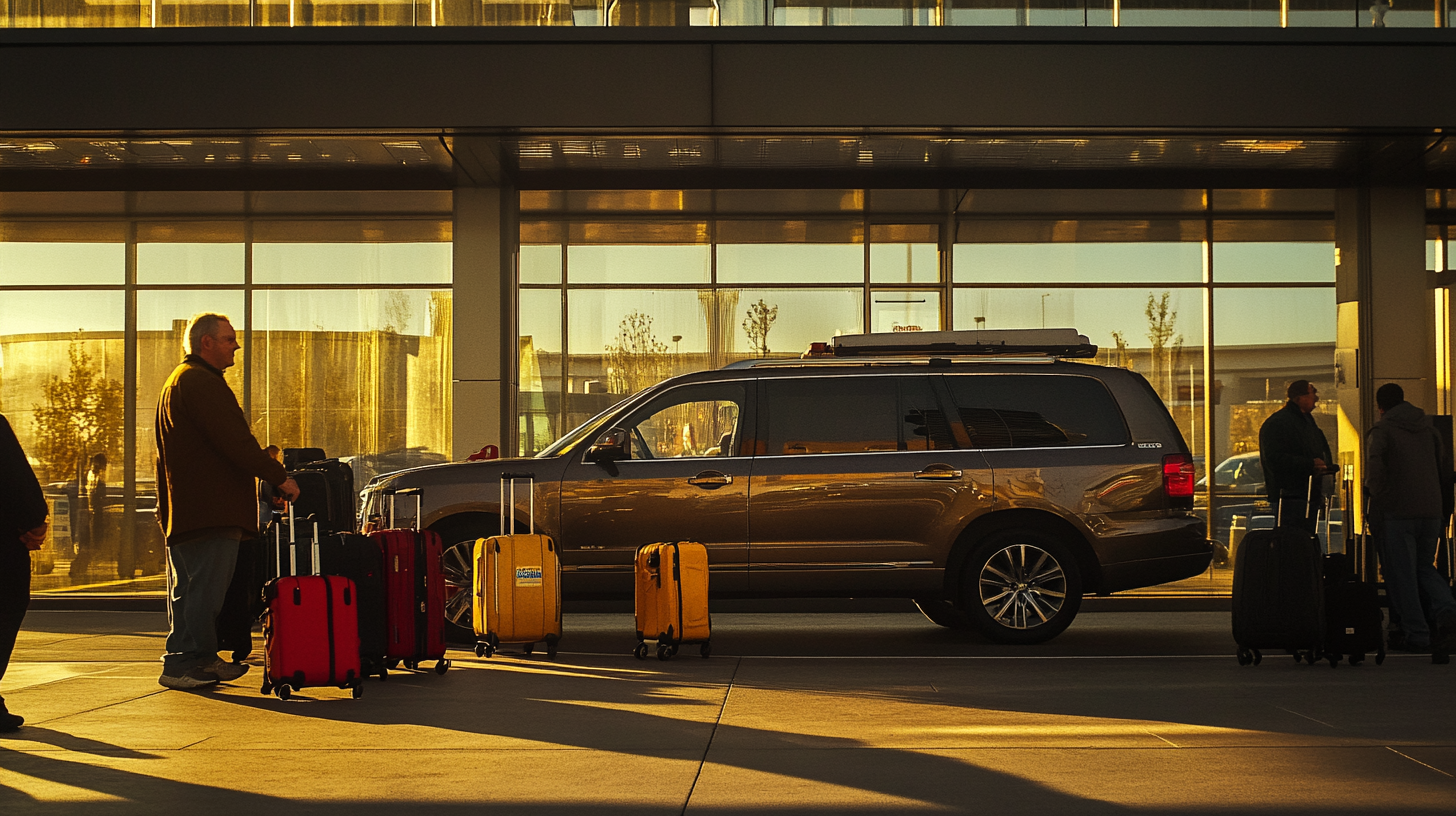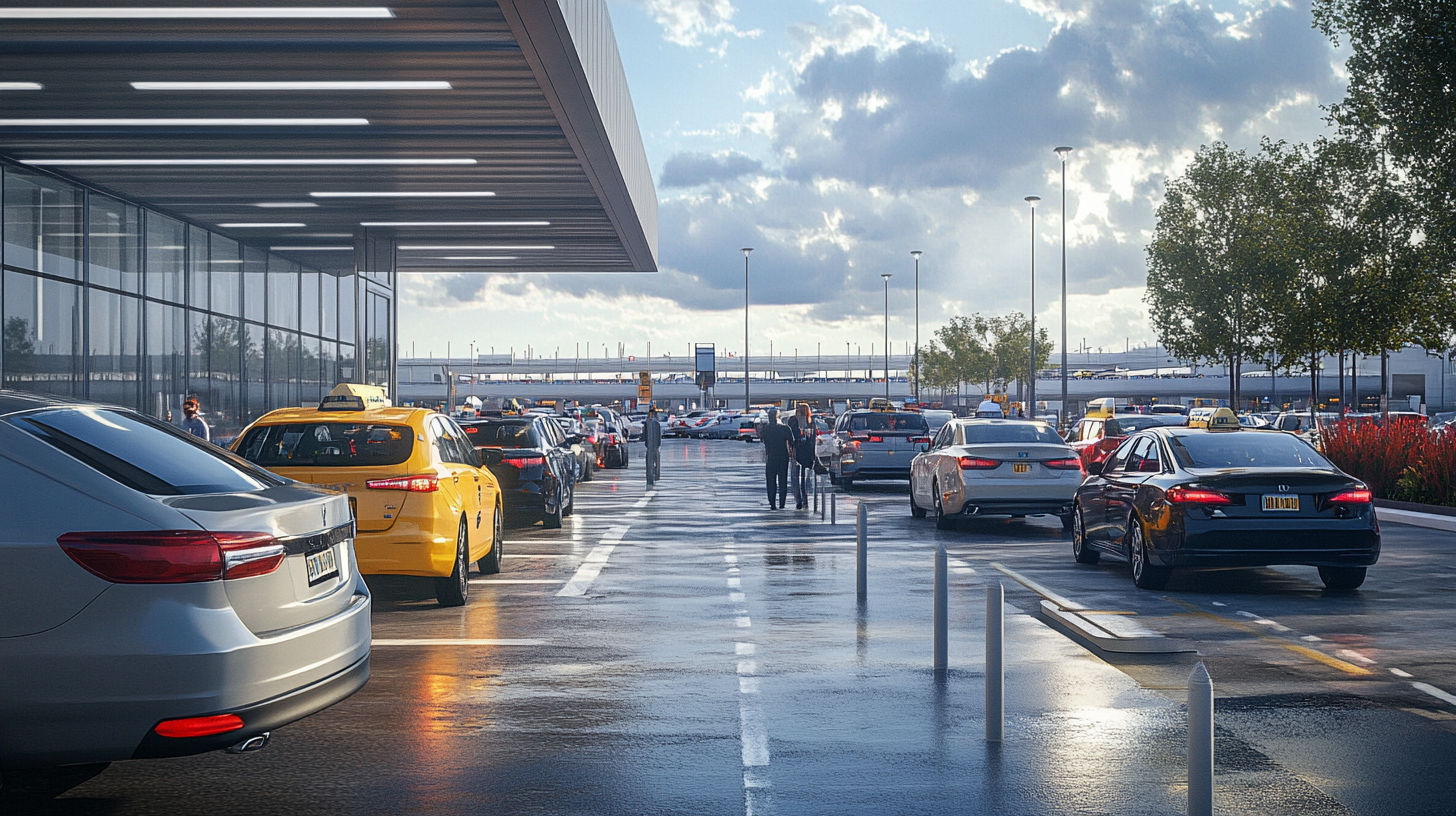Private Airport Transfers vs. Rideshares vs. Taxis: Choosing the Best Option for Your Journey
Traveling to a new destination often brings a mix of excitement and uncertainty. After the hustle of airports and flights, the last thing any traveler wants is to struggle with getting to their final destination. Imagine stepping off a long-haul flight, luggage in hand, and facing a myriad of transportation choices, each with its own set of advantages and drawbacks. With options ranging from luxurious private transfers to traditional taxis and modern rideshares, making the right choice can significantly impact the start of your trip. This comprehensive guide delves into the nuances of each transportation mode, providing valuable insights to help you navigate your choices confidently and tailor your journey according to your preferences, budget, and specific travel needs.
Understanding Your Airport Transportation Options

When you step off the plane, the last thing you want is to face confusion or delays in reaching your destination. Airport transfers are pre-arranged services designed to transport travelers from the airport to their accommodation or other desired locations. The main options include:
- Private Airport Transfers
- Rideshares
- Taxis
Each of these services offers unique benefits and drawbacks. Let’s delve deeper into what each entails.
Private Airport Transfers: Luxury and Convenience

Private airport transfers involve booking a dedicated vehicle and professional chauffeur to transport you directly to your destination. This personalized service often includes a driver waiting for you at arrivals with a sign bearing your name, assistance with your luggage, and an escort to a high-quality vehicle parked conveniently close. This option is ideal for travelers seeking comfort, privacy, and a seamless transition from the airport to their destination without the hassle of navigating public transport or waiting in queues.
Advantages of Private Transfers

- Comfort and Luxury: High-end vehicles equipped with amenities like Wi-Fi, climate control, plush seating, and spacious interiors that allow you to relax after a long flight. Some services offer a fleet of luxury sedans, SUVs, or even limousines to cater to your preferences.
- Personalized Service: Flexible scheduling, customized itineraries, and professional drivers who prioritize your needs. Whether you require child seats, have specific requests, or need to make additional stops, private transfers can accommodate special requirements with ease.
- Privacy: Exclusive use of the vehicle without sharing with other passengers, allowing for confidential conversations or simply a peaceful ride.
- Reliability: Pre-booked services ensure your ride is ready upon arrival, minimizing wait times. Drivers often monitor flight schedules to adjust for delays, providing peace of mind that your transportation is secure regardless of unforeseen changes.
- Professionalism: Drivers are typically trained, licensed professionals with local knowledge, which can enhance your safety and provide insights into the area during your ride.
Disadvantages of Private Transfers

- Cost: Generally more expensive due to premium services and amenities. Prices can vary widely depending on the provider, vehicle type, and additional services requested.
- Advance Booking Required: May not be suitable for spontaneous travelers or last-minute plans, as these services typically need to be arranged ahead of time.
- Cancellation Policies: Strict cancellation policies may apply, potentially leading to fees if travel plans change unexpectedly.
For example, dedicated private transfer services in major cities offer private black car options worldwide, providing a seamless and comfortable experience without surge pricing. These services often align with flight arrivals, ensuring that even if your flight is delayed, your driver will be there when you land.
Rideshares: Modern Convenience at Your Fingertips

Ridesharing apps like Uber and Lyft have revolutionized urban transportation by connecting passengers with drivers through a mobile app. With just a few taps on a smartphone, travelers can request a ride, choose their preferred vehicle type, and pay automatically through the app. These services are known for their convenience, competitive pricing, and the ability to provide on-demand transportation without the need for cash transactions or language proficiency. The widespread adoption of rideshares has made them a go-to option for many travelers seeking a balance between cost and convenience.
Advantages of Rideshares

- App-Based Booking: Easy to request a ride directly from your smartphone at any time. The intuitive apps display driver profiles, vehicle details, and estimated arrival times, making the process user-friendly.
- Cost-Effective: Often cheaper than traditional taxis, especially during non-peak hours. Rideshares frequently offer promotions, discounts, and loyalty programs to further reduce costs.
- Variety of Vehicle Options: Choose from standard cars, luxury vehicles, to larger options like SUVs or vans based on your group size and luggage needs. Some services even offer shared rides at lower costs if you’re willing to share with other passengers heading in the same direction.
- Cashless Transactions: Payments are processed through the app, reducing the need for cash and simplifying the expense tracking process. Receipts are emailed directly, which is convenient for business travelers.
- Real-Time Tracking: Ability to track your driver’s location and estimated arrival time. This feature enhances safety and allows you to share your trip details with others for added security.
- User Ratings and Reviews: You can view driver ratings and leave feedback, which maintains a level of quality and accountability within the service.
Disadvantages of Rideshares

- Surge Pricing: Fares can increase significantly during peak times, holidays, or bad weather, sometimes exceeding the cost of traditional taxis or private transfers.
- Variable Availability: Services may not be available in all regions or airports. In certain countries or cities, rideshare operations may be restricted or even banned due to local regulations.
- Lack of Regulation: Less regulated than taxis, which can affect driver quality, vehicle maintenance standards, and overall safety. Background checks and vehicle inspections might not be as rigorous.
- Capacity Limitations: Standard rideshare vehicles may not accommodate large groups or excessive luggage. While options for larger vehicles exist, they may be limited or more costly.
- Dependency on Technology: Requires a functioning smartphone and internet connection, which can be problematic if you have limited data access or your phone battery is low.
It’s important to consider the local context; for instance, rideshares are restricted at certain airports or may have designated pickup zones that are difficult to find, making taxis or other services a more straightforward option. In some countries, local regulations favor traditional taxi services, impacting the availability and legality of rideshares. Always check the local situation before relying on a rideshare service.
Taxis: Traditional Reliability and Accessibility

Taxis have been a staple of urban transportation for decades, offering on-demand rides without the need for apps or advance bookings. With recognizable vehicles and licensed drivers, taxis provide a familiar and straightforward transportation option. They are especially convenient for travelers who may not have access to a smartphone, are unfamiliar with local technology services, or prefer to deal directly with a driver.
Advantages of Taxis

- Immediate Availability: Easily hailed from designated taxi stands, especially at airports, train stations, and popular city areas. There’s no need to wait for a driver to arrive.
- Regulated Services: Subject to local regulations, which can enhance safety and reliability. Taxi drivers typically hold specific licenses and are required to adhere to standards for vehicle maintenance and customer service.
- Fixed Pricing: Some regions offer flat rates from airports to popular destinations (e.g., Rome), removing uncertainty about fare costs.
- Payment Flexibility: Accept cash and sometimes credit cards without the need for an app or pre-registered payment methods. This is convenient for travelers who prefer traditional payment methods or are wary of sharing financial details digitally.
- Local Knowledge: Taxi drivers often have extensive knowledge of the local area and traffic patterns, and can suggest routes or provide insights about the destination.
Disadvantages of Taxis

- Cost Variability: Meter-based fares can be unpredictable, potentially higher during heavy traffic or due to less direct routes taken by the driver.
- Lack of Amenities: Generally offer basic transportation without additional comforts found in private transfers or certain rideshares.
- Availability Issues: Can be scarce during peak times, inclement weather, or in less populated areas, making it difficult to secure a ride when needed.
- Language Barriers: Communication might be challenging in foreign countries without language proficiency, potentially leading to misunderstandings about destinations or fares.
- Payment Limitations: While taxis may accept cash, some may not accept credit cards or foreign currency, posing a challenge for international travelers.
In some cities, taxis might be a more economical or practical choice, especially when considering the balance between cost and convenience. For example, a visitor to Chicago found that taxis or rideshares were significantly cheaper than a £141 ($180) quoted price for a private transfer. This illustrates the importance of comparing options and understanding local fare structures to avoid overpaying for transportation.
Comparative Analysis: Factors to Consider

1. Cost Considerations

Your budget plays a crucial role in deciding the best transportation option.
- Private Transfers: Higher cost for premium service, but with the benefit of fixed pricing regardless of traffic conditions or delays.
- Rideshares: Generally affordable but subject to surge pricing during high-demand periods, which can significantly increase costs unexpectedly.
- Taxis: May be costlier than rideshares during normal times but offer stable pricing during peak times due to regulated fares.
For budget-conscious travelers, shared airport shuttles or public transportation might offer the most savings, albeit with trade-offs in convenience and flexibility. Evaluating the trade-off between cost and comfort is essential in making the right choice for your needs.
2. Convenience and Flexibility

Consider how important convenience is for your journey. If you value a hassle-free experience, certain options may stand out.
- Private Transfers: Offer door-to-door service on your schedule, eliminating the uncertainty of wait times or navigation. Ideal for travelers with tight schedules, late-night arrivals, or those unfamiliar with the local language and customs.
- Rideshares: Provide on-demand service but are dependent on app connectivity and driver availability. You may need to wait for a driver to accept your request, and pick-up locations at airports can be confusing or distant.
- Taxis: Readily available at airports but may involve waiting in lines during busy periods. No need for an app or prior arrangement, which can be convenient for spontaneous travelers.
Pre-booking private transfers ensures no delays, while rideshares and taxis offer more flexibility for spontaneous travel. Assessing your tolerance for potential wait times and navigation challenges can help determine the best option.
3. Comfort and Amenities

If comfort is a priority, the amenities offered by each option vary.
- Private Transfers: High-end vehicles, professional chauffeurs, and personalized attention. Amenities may include refreshments, Wi-Fi, and entertainment systems.
- Rideshares: Standard vehicles with basic comfort; options like Uber Black offer luxury at a higher price. Amenities depend on the driver and vehicle selected.
- Taxis: Basic transportation without extra amenities. Vehicles may vary in condition and comfort levels.
Travelers seeking a premium experience may prefer private transfers or specialized rideshare services. Considering the length of your journey and personal comfort preferences can guide your choice.
4. Group Size and Luggage

The size of your traveling party and the amount of luggage can influence your choice.
- Private Transfers: Can accommodate groups with larger vehicles upon request. Ideal for families or large parties requiring extra space.
- Rideshares: May have limitations; larger groups might need to request a rideshare option that offers larger vehicles, which may not always be available.
- Taxis: Standard taxis have limited space; may not handle excessive luggage or accommodate more than four passengers comfortably.
Airport shuttles offer an alternative for groups, providing cost-effective transportation with sufficient space. Assessing your group’s specific needs ensures a comfortable and efficient journey.
5. Safety and Regulations

Safety is paramount when traveling in unfamiliar areas.
- Private Transfers: Professional drivers and regulated services enhance safety. Vehicles are typically well-maintained, and companies have reputations to uphold.
- Rideshares: Offer real-time tracking but are less regulated than taxis. Safety can vary depending on the driver, and background checks may be less stringent.
- Taxis: Heavily regulated, providing a sense of security through adherence to local laws. Drivers are licensed, and vehicles are inspected regularly.
Understanding local regulations and choosing reputable providers can mitigate safety concerns. Checking reviews and seeking recommendations can also enhance your peace of mind.
6. Local Availability and Context

Not all services are available everywhere. For instance:
- Rideshares: May not operate in certain countries or regions. Local alternatives may exist, but they might not offer the same level of service.
- Taxis: Universally available but quality and pricing vary by location. In some areas, taxis may be the only regulated option.
- Private Transfers: Require advance booking and may not be feasible for spontaneous trips. Availability depends on local providers.
Researching your destination’s transportation landscape is essential for effective planning. Understanding the local context ensures that you choose an option that is both available and appropriate for your needs.
Case Studies and Examples

Rome’s Flat-Rate Taxis

In Rome, taxis offer flat rates from the airport to the city center, providing a reliable and straightforward option for travelers. This system eliminates the uncertainty of meter-based fares and can be more convenient than arranging a rideshare or private transfer. Knowing about such fixed-rate services can help travelers budget more effectively and avoid unexpected costs.
Phoenix Airport Shuttle Services

Companies like Airport Shuttle of Phoenix LLC provide 24/7 door-to-door shuttle and car services from PHX Sky Harbor International Airport. They are praised for affordability, reliability, and convenience, making them an excellent choice for travelers needing transportation across Arizona. Services like these highlight the value of researching local transportation options, as affordable airport shuttle services in Phoenix can offer a balance between cost and convenience.
Chicago’s Overpriced Private Transfers

A traveler to Chicago was quoted £141 ($180) for a return trip from the airport to their hotel. Local suggestions highlighted that this price was excessive compared to using Uber or taxis, which typically cost around $35 one-way from O’Hare International Airport to downtown Chicago. This example underscores the importance of comparing options to avoid unnecessary expenses and illustrates how traditional taxis or rideshares can be more economical in certain cities.
Tips for a Seamless Travel Experience

1. Research and Plan Ahead

Understanding the transportation options at your destination can save time and money. Consider factors like local regulations, availability of services, and typical costs. Resources such as travel forums and destination guides can provide valuable insights from fellow travelers.
2. Pre-Book When Possible

Booking services like private transfers in advance ensures availability and can lock in prices, avoiding surge pricing or peak-time rate increases. This is especially important during holidays or major events when demand is high.
3. Consider Group Needs

For large groups or travelers with significant luggage, ensure your chosen transport can accommodate your needs. Private transfers or larger rideshare options may be necessary. Coordinating in advance can prevent last-minute complications.
4. Be Mindful of Safety

Choose reputable services with good reviews. In regions where rideshares are less regulated, taxis or private transfers might offer greater security. Familiarize yourself with local emergency numbers and stay aware of your surroundings.
5. Balance Cost and Convenience

Your budget doesn’t have to compromise your comfort. Compare options to find the best balance between affordability and the level of service you desire. Sometimes spending a bit more can significantly enhance your travel experience.
Final Thoughts
Choosing between private airport transfers, rideshares, and taxis depends on various factors, including budget, convenience, comfort, group size, and safety considerations. By understanding the advantages and disadvantages of each option and considering your personal travel needs, you can select the transportation method that best enhances your journey. Whether you prioritize luxury and personalized service or seek cost-effective and flexible options, thorough research and planning are key to a seamless travel experience.
Follow us back to milesBUZZ for more travel insights and tips. Embracing the right transportation choice sets a positive tone for your trip, allowing you to focus on exploring new destinations and creating lasting memories.







